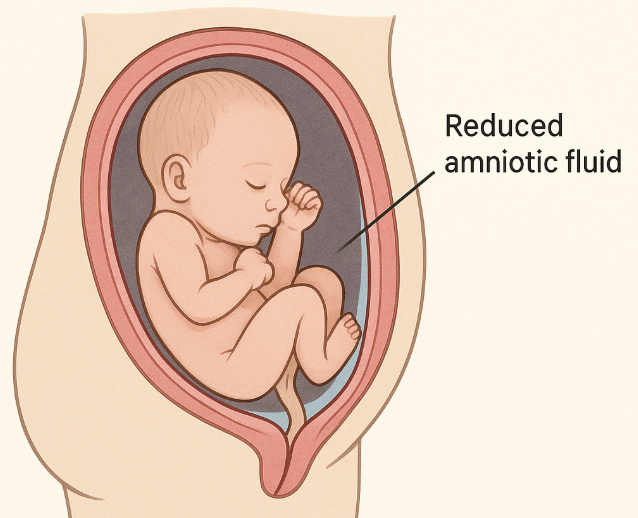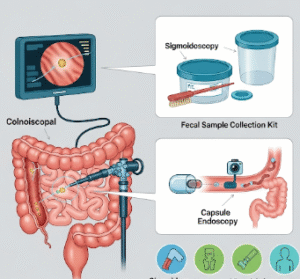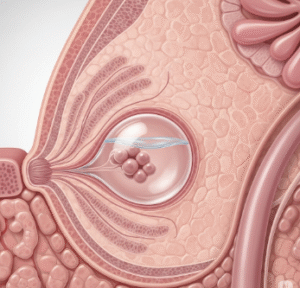Overview
Oligohydramnios is a pregnancy complication characterized by too little amniotic fluid surrounding the baby in the womb. Amniotic fluid plays a vital role in fetal development, cushioning the baby, allowing for proper growth, and supporting lung and digestive system development. When the levels of this fluid drop below the normal range, it can pose risks to both the mother and the baby, especially during the second or third trimester. Early detection and proper management are essential to ensure a healthy outcome.
What is Oligohydramnios?
Oligohydramnios is defined as a condition where the amniotic fluid index (AFI) measures less than 5 cm on an ultrasound, or the maximum vertical pocket (MVP) is less than 2 cm. This condition can occur at any point during pregnancy, but it’s most common in the third trimester. It may be acute or chronic and can lead to complications if not properly managed. It affects about 4% of pregnancies overall but may be more common in high-risk pregnancies.
Symptoms
Oligohydramnios often does not cause noticeable symptoms in the early stages, but signs may include:
- Leaking fluid from the vagina (suggesting rupture of membranes)
- Measuring small for gestational age
- Reduced fetal movement
- Premature labor symptoms
- Abnormalities found on prenatal ultrasound
Causes
Several factors can contribute to low amniotic fluid levels, including:
- Rupture of membranes (water breaking early)
- Placental insufficiency, where the placenta is not supplying enough blood and nutrients
- Birth defects, particularly involving the kidneys or urinary tract
- Post-term pregnancy (beyond 42 weeks)
- Maternal health conditions, such as high blood pressure, diabetes, or dehydration
- Medications, such as ACE inhibitors or NSAIDs during pregnancy
Risk Factors
Certain women are at higher risk of developing oligohydramnios, including:
- Those with a history of pregnancy complications
- Mothers carrying twins or multiples
- Women with chronic health issues
- Older maternal age
- Smokers or those with poor nutrition
- Those with a previous pregnancy affected by oligohydramnios
Complications
Without appropriate management, oligohydramnios can lead to:
- Restricted fetal growth (intrauterine growth restriction, IUGR)
- Preterm birth or need for early delivery
- Umbilical cord compression
- Increased risk during labor (e.g., meconium aspiration, low Apgar scores)
- Fetal kidney or lung underdevelopment
- Stillbirth in severe, untreated cases
Prevention
Although not all cases are preventable, there are steps that can reduce the risk or allow for early management:
- Regular prenatal visits and ultrasound monitoring
- Staying hydrated
- Managing chronic conditions like hypertension or diabetes
- Avoiding medications that can reduce amniotic fluid
- Monitoring fetal movements, especially in the third trimester
- Reporting any fluid leakage immediately to your doctor
Treatment Options in Korea
South Korea offers world-class maternal-fetal care with modern diagnostic tools and neonatal support. Treatment for oligohydramnios depends on the gestational age and the underlying cause, and may include:
- Maternal hydration therapy: Drinking fluids or receiving IV fluids can sometimes increase amniotic fluid levels
- Close fetal monitoring: Frequent ultrasounds and non-stress tests to assess baby’s health
- Amnioinfusion: Introducing saline or lactated Ringer’s solution into the amniotic sac during labor to cushion the baby and relieve cord compression
- Early delivery: In cases where the baby’s health is at risk and gestation is far enough along, delivery may be recommended
- Treating underlying conditions: Managing diabetes, hypertension, or infections effectively
Top hospitals in South Korea like CHA Fertility Center, Asan Medical Center, and Seoul National University Hospital provide advanced obstetric care, high-resolution fetal imaging, and neonatal intensive care, ensuring the best outcomes for pregnancies affected by oligohydramnios.













